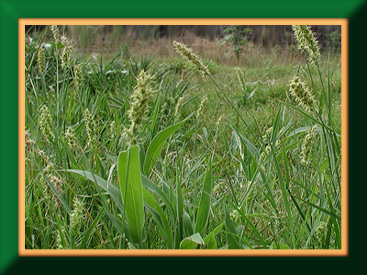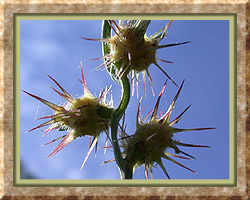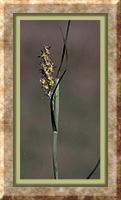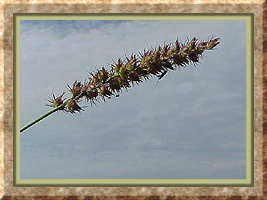There are several species of the sandspur that grow in Florida. The most prevalent specie, the Southern Sandspur, is Cenchrus echinatus L. Cenchrus is from the Greek word for millet, cenchros. The Greek species name echinatus means armed with spines. Generally, it is considered a 'weed' because of the pain inflicted by the burrs on contact with the skin.
If you want to meet a sandspur, look for a slender stem, about a foot or more in height, growing above a grassy-looking base. A cluster of seedpods adorns the top of the stem. The seedpod resembles a pea that has numerous short, sharp needles protruding from its surface.
The sandspur was an integral part of our environment in Panama Park.
In late spring it is time to shed shoes and shirt. At this stage, feet are tender and we have to carefully avoid sandspur patches. You dare not walk next to anyone near a sandspur patch. A slight shove could result in stepping on the painful spines. Removing the sandspurs sticking to the bottom of your feet is painful and has to be done with care. If one of the spines breaks off into the skin the spot often festers. This requires extraction of the foreign body, using a sharp needle or similar object. My mother can perform this operation blindfolded, and sometimes I think she does.
As summer progresses, the bottoms of feet become tougher but the sandspur has a counter tactic. As the sandspur matures the seedpods become drier and harder, and the spines become stronger and sharper. The feet eventually win. By the end of summer the soles of feet are like shoe leather. We can walk on sand or asphalt pavement heated to near boiling by the Florida sun and not even wince. But other parts of the body are vulnerable.
In the center of Panama Park is a playground appropriately named “Panama Park”. It is also affectionately known as “The Sandspur Bowl”. The park has the standard amenities such as a baseball field, a softball field, basketball courts, swings, slides, etc.. There is also an open area where we play football. More sandspurs grow in this area, it seems, than anywhere else in the park. If you are carrying the ball, you obviously try to avoid being tackled, but even more important is to avoid being tackled in a sandspur patch. Timeouts are allowed to remove sandspurs from your skin only if they are near your eyes. Of course, only sissies wear shirts when playing football.
A few times when riding in Charlie’s jeep, Charlie would drive into the park and do figure 8s, sudden stops and starts, quick turns and other maneuvers trying to throw us out of the back of the Jeep and preferably into sandspur patches. It worked the first couple of tries. A broken bone would hurt less than sandspurs all over your body
Sandspurs make a good weapon if you know how to use them. Charlie is an expert. He selects a mature sandspur and breaks off the stem at the base. Holding the bottom of the stem between his thumb and index finger, he throws the sandspur with a quick flick of the wrist. In most instances, the spines of the sandspur adhere to the skin of the victim. Ernie is a good target. He has lots of skin area.
If you aren't proficient in throwing sandspurs, you can always use the whip method. We frequently practice this on Knox. You simply hold the end of the sandspur stem and whip it onto the unsuspecting body. This is nearly always successful in sticking the sandspur to Knox's bare back. We attack his back because his legs are well protected with hair.
Many consider the sandspur a noxious weed. I don’t. Not as stately as a majestic oak tree royally decorated with wisps of silvery moss. Not as serene as a blue summer sky punctuated with billowy white clouds. Not as intriguing as a mist covered pond surrounded by brush and cattails. Just another wonder of nature that boys find fascinating and entertaining and just as memory evoking.




